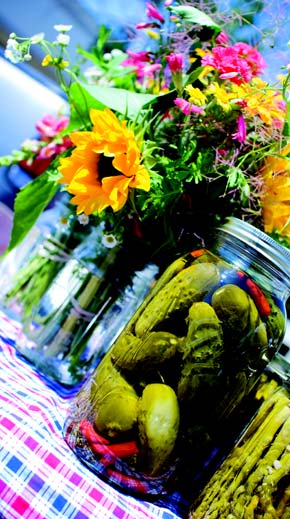The farmers’ market doesn’t need any promotion this month; you can pretty much follow your nose to find the best bargains in town. Do I honestly need to wax poetic over the flavor and aroma of an organically-grown tomato? How about snappy-fresh green beans? Or sweet corn on the cob, picked that very same morning? Does your neighborhood supermarket bring in a truckload of juicy, vine-ripened watermelons every Saturday morning? I don’t think so. These are a few of the more obvious summer pleasures available at the market, but some savvy shoppers also zoom in on less popular seasonal treasures.
Cucumbers are a mainstay of the vegetable world. So ubiquitous, that a lot of people don’t even think of them as vegetables. Year ‘round we see them for sale—waxed-up to shine like a new car and piled into towering pyramids in the produce section of supermarkets, where they are periodically misted with a fine spray to provide the allusion of freshness. For better or for worse they’re everywhere—sometimes bitter and hard to digest—mixed with plain yogurt and herbs for a cooling raita; mounded onto crudités platters; and tucked inside prissy little tea sandwiches. Even the lowliest coffee shops routinely toss a few limp, seedy slices into their anemic green salads. For a long time I became so accustomed to lousy cucumbers that I just stopped buying them. But then—ta da!—a revelation. Cucumbers can be crunchy and moist, with a refreshing, slightly grassy aroma. Now is the time to find them; though if you are looking for small ones, you may have to stand in line with the picklers.
Dill pickles seem to get all the attention, and that’s fine with me. I love them; and fortunately there are a lot of good ones available commercially. Bread and Butter pickles are another story. They are really quite easy to make, and the resulting pickles are far more crisp and complex-tasting than the sugary-sweet ones you find on grocery store shelves. My favorite recipe below was inspired by the late great cookbook author, Sheila Lukins.
BREAD & BUTTER PICKLES
4 pounds Kirby (waxless) cucumbers, about 4 inches long, ends trimmed, cut crosswise into 1/4-inch slices (about 12 cups)
2 pounds small white or yellow onions, thinly sliced
1/3 cup coarse (kosher) salt
Ice
3 cups cider vinegar
2 cups granulated sugar
2 tablespoons yellow mustard seeds
2 teaspoons ground turmeric
2 teaspoons celery seeds
1 teaspoon ground ginger
1 teaspoon whole black peppercorns
1/2 teaspoon crushed hot red pepper flakes1.Place the cucumbers, onions, and salt in a large bowl and toss well to combine. Completely cover the surface with ice and let stand in a cool place for 2 hours. (This step is necessary to crisp the cucumbers.) Drain, rinse, and drain again.
2.Combine the vinegar, sugar, mustard seeds, turmeric, celery seeds, ginger, peppercorns, and pepper flakes in a large, heavy, non-reactive pot and bring to a boil, stirring occasionally to dissolve the sugar. Stir in the prepared cucumbers and onions, and return to a boil. Cook 1 minute, then remove from the heat.
3.Pack the hot pickles into 5 or 6 sterilized pint jars, making sure there are no air pockets. Cover with the hot syrup, leaving 1/4 inch of head space in each jar. Seal and process in a boiling-water bath for 10 minutes*, following the instructions provided with the canning jars. Makes 5 or 6 pints.
* If you prefer to avoid the canning process, simply let the pickles cool to room temperature before screwing the lids onto the jars; then store in the refrigerator.
The 411 on Cukes
–Thought to be native to either India or Thailand, cucumbers are one of the oldest cultivated vegetables. Columbus introduced them to the Western world in the late fifteenth century; and by the time the Pilgrims arrived, the Iroquois were already growing them.
–Cucumbers consist of up to 90% water. A cup of chopped or sliced cukes weighs in at a mere 16 calories, is virtually fat-free, and very low in carbs.
–Refrigerate cucumbers—unwashed and unsliced—in an open plastic bag in the crisper drawer of the refrigerator. When handled properly, farm-fresh cucumbers can last up to 1 week.
–Everyone recognizes the long, narrow English hothouse cucumber (sometimes labeled “seedless” or “burpless”) that is unwaxed but encased in plastic to preserve moisture. The common garden-variety cukes sold commercially are often coated with an oily wax substance to prolong their shelf life. (You’ll find them unwaxed at the farmers’ market, so you won’t have to deal with that nasty stuff.) Expand your horizons this month and try a few other varieties, like round lemon cucumbers; narrow Japanese cucumbers with thin, bumpy skin; ridged Armenian cucumbers, which are often long and twisted; and slender, thin-skinned Baby Persian cucumbers. Kirby is actually a generic name for pickling cucumbers. They are bred to be short, slightly chubby, crunchy, and rarely over 4-inches long, with bumpy skin and fewer seeds, making them ideal for any kind of pickle.
–Beat the summer heat with Spa Water: Put some cucumber slices in a pitcher along with a sprig or two of fresh mint; then fill with cool water. Refrigerate at least 2 hours, until the water is icy cold and infused with flavor. To serve, strain or not—as you please. No calories, but plenty of pizzazz.
The Danville Certified Farmers’ Market, located at Railroad and Prospect, is open every Saturday, rain or shine, from 9 a.m. until 1 p.m. For specific crop information call the Pacific Coast Farmers’ Market Association at 1-800-949-FARM or visit their web site at www.pcfma.com.

